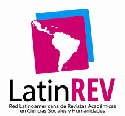Publication norms
Author guidelines
Papers presented may be research articles, essays andsystematic bibliographic reviews. Templates: for article submission / for abstract submission (only for calls that require it)
- Papers should be original and unedited. They should not be part of any other evaluation process, be it a national or international publication. If the manuscript comes from a thesis or research work to obtain a degree, the authors must indicate this in the comments section to the editor and in the originality letter.
- Papers may be written in Spanish, English or Portuguese and sent in .doc or .docx extension documents (MS Word). They should not surpass 7,000 words, including titles, subtitles, author names and affiliations, abstracts, footnotes, tables, figures, captions and references, with 1.5 spacing and Times New Roman 12 font.
- Authors must attach a letter of originality that needs to be signed by all the authors. By doing that, you are also authorizing the publication of the article in case it gets accepted.
- Starting in 2022, as part of the efforts aimed at the internationalization of the journal, Contratexto will promote the publication in English of the articles in Spanish and Portuguese. If the authors have financing for the professional translation of their texts once approved, they must indicate this when submitting their article. Once the article is approved, they must submit the translated version of their article and the corresponding proof of professional translation so that they can undergo style correction by the Editorial Fund of the University of Lima.
General guidelines for research articles:
- Presentation page:
- Standard name:
- Institutional mail:
- Institutional affiliation:
- Academic degree:
- ORCID code (mandatory), Google Scholar, ScopusID and Publons (optional)
- Supporters: Indicate whether the submitted manuscript derives from a project financed with funds or institutional support from national or international competitive calls.
- Spanish translation: Indicate whether the authors have their own funding to professionally translate the submitted manuscript into Spanish.
- Code of ethics: Indicate the ethical considerations that were taken into account in conducting this research (only if it was necessary for this research).
- Conflict of interest: Indicate if there is or was a conflict of interests that has influenced this manuscript.
- Author Contributions: According to the CRediT Taxonomy (Brand et al., 2015), indicate the contribution of each author of the manuscript using their initials.
- Page 1: Complete title, abstract (200 words), 5 keywords. This should also be in English, Spanish and Portuguese. The abstract must clarify the study’s objective, relevance, methodology, results and contribution to its field.
- .
- Page 2 onwards: Title and anonymized text, without the author’s name. Research articles should follow the IMRaD structure: introduction, methods, results, and discussion . At the end of the text, references and corresponding annexes (instruments and other relevant information) must be included.
- .
- Of in-text citations and references
- Prioritize indexed references of scientific journals for articles. They should be formatted according to the 7th edition of the 7ª edición del American Psychological Association (APA) Publication Manual..
- The in-text citations should look like this: (Author’s last name, year, page). If paraphrased, page numbers should not be included. For more information on citation formats see APA manual 7th edition.
- Information footnotes should be avoided. If these included any citation, they should also be adapted to APA style. Footnotes do not exempt the responsibility of citing the source of information.
- Book reference:
Díaz-Albertini, J. (2016). El feudo, la comarca y la feria. La privatización del espacio público. Universidad de Lima Fondo Editorial.
- Article in an academic or scientific journal with doi number:
Gómez Gabriel, N. (2020). Espectropolítica: imagen y hauntología en la cultura visual contemporánea. Contratexto, (034), 153-176. https://doi.org/10.26439/contratexto2020.n034.4871
- Article in an academic or scientific journal without doi number:
Sierra, F. y Gravante, T. (enero-junio 2016) Ciudadanía digital y acción colectiva en América Latina. Crítica de la mediación y apropiación social por los nuevos movimiento sociales. La trama de la comunicación, 20(1), 163-175. http://www.latrama.fcpolit.unr.edu.ar/index.php/trama/article/view/568/423
- Press article reference:
Vargas Llosa, M. (21 de setiembre de 2003). La verdad sospechosa. El País, p. A8.
- Of images, graphics and tables
- Tables and figures (visual elements as images, infographics, statistical graphics, etc.) should be included and mentioned in text. During diagramming, these will be placed as near as possible to where they are mentioned. They should be presented with the information established by APA 7th edition rules.
- Additionally, images should be provided in a separate file, in .JPG, .PNG or .TIFF format, with a resolution of 300 dots per inch. Each image should be authorized for reproduction or have a Creative Commons license (or similar).
- Tables should be provided in a separate file, .xls or .xslx formats (MS Excel). The maximum size of a table should not exceed one page and must ensure readability.
Guidelines for essays or bibliographical reviews
- Essays should contribute exhaustive, original and critical points of view. They are subjected to the same conditions regarding extension, presentation and references aforementioned.
- Bibliographical reviews should be exhaustive and must use the appropriate methodology for this kind of studies. They are subjected to the same conditions regarding extension, presentation and references aforementioned.
- Any type of content published on Contratexto goes through style editing by our publishing house.
- Peer reviewers receive a digital certificate indicating their contribution to the journal.
Information and indexation services:
Contratexto is currently registered in the databases and directories of the following institutions:
- Scopus
- SciELO Perú
- Redalyc
- Latindex (Sistema Regional de Información en Línea para Revista Científicas de América Latina, el Caribe, España y Portugal)
- Dialnet (Website for the distribution of hispanic scientific production)
- Portal de la Comunicación Incom-UAB (Specialized information on the different topics of communication studies)
- MIAR (Matriz de Información para el Análisis de Revistas)
- Infoamérica (UNESCO Chair for Communication studies from the University of Malaga)
- DOAJ (Directory of Open Access Journals)
- LatinREV (Red Latinoamericana de Revistas Académicas en Ciencias Sociales y Humanidades)
- Google Scholar
- EBSCO
















